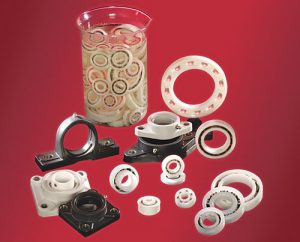
A bearing is a common machinery component that’s used to regulate the motion and reduce the friction of a moving part. It restricts relative movement to reduce the load placed on the part and the machine. In fact, the word “bearing” is a combination of the words “to bear,” reflecting the component’s ability to bear loads. But there are different types of bearings, including plain, ball, roller, fluid and magnetic.
Plain Bearings
The most basic type, plain bearings consist of a flat surface without any balls or rollers. Furniture drawers, for example, often have plain bearings on which the individual drawers glide out and back in. Plain bearings like flat wheels, and like other bearings, are placed between two surfaces to reduce friction.
Ball Bearings
Ball bearings are characterized by their circular shape in which many small balls are housed. They reduce friction while taking both radial and axial loads off a moving part. According to Wikipedia, ball bearings were invented in the late 1700s by Welsh entrepreneur Philip Vaughn who filed a patent for the machinery component. Since then, ball bearings have become a popular choice among manufacturers because of their high tolerance for misalignment.
Roller Bearings
Also known as a rolling element bearing, a roller bearing is a type of bearing that contains the rolling elements — either balls or rollers — in circular-shaped races. The races allow the rolling elements to seamlessly roll, all while bearing the weight of the load. Roller bearings are particularly effective at bearing heavy radial loads — even more so than ball bearings. The downside is that they aren’t effective at bearing heavy thrust loads.
Fluid Bearings
Fluid bearings are designed to take the load off a moving part while also reducing friction, but unlike the other bearings previously mentioned, they don’t contain moving balls or rolling elements. Instead, they contain liquid between The fluid creates a thin layer to which the moving part is exposed, allowing it to bear the load. Most fluid bearings contain water or oil, both of which are effective at reducing friction.
Magnetic Bearings
In addition to fluid bearings, magnetic bearings are another unique alternative to traditional rolling-style bearings. Featuring powerful magnets, they use magnetism to lift and bear loads without creating direct contact. Magnetic bearings literally levitate moving parts into the air, allowing for little or no friction. Of course, they only work when used in conjunction with ferromagnetic metals.
